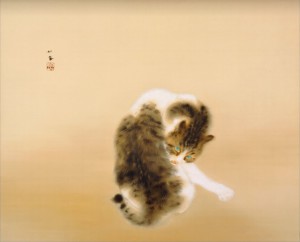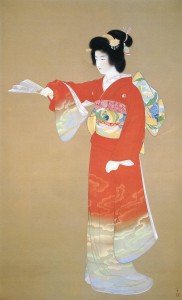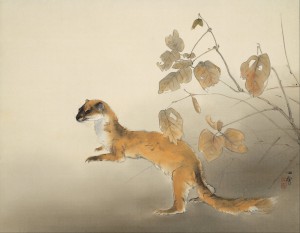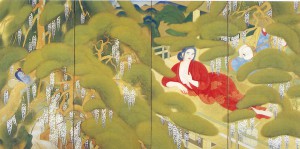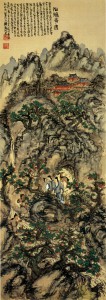Kyoto School / Schools of Nihonga 005
Kyoto School
“Kyoto School” is a term that refers to the artists of the Kyoto circle of nihonga (Japanese-style paintings) after the Meiji period. Toward the end of the Edo period, *Kanou School and *Tosa School were active in Edo while *Maruyama/Shijou School and painters of *nanga were active in Kyoto.
*Kanou School:
Kanou School is a school of painting from the mid-Muromachi period to the early Meiji period that follows the lineage of Chinese-style painting.
*Tosa School:
Tosa School of Japanese painting was founded in the early Muromachi Period (14th-15th centuries), and was devoted to yamato-e, paintings specializing in subject matter and techniques derived from ancient Japanese art, as opposed to schools influenced by Chinese art, namely the Kanou School. Tosa School paintings are characterised by “areas of flat opaque color enclosed by simple outlines, where drawing is precise and conventional,” with many narrative subjects from Japanese literature and history. However by the 17th century both Tosa and Kanou artists broadened their range, and the distinction between these and other schools became less clear.
*Maruyama/Shijou School:
Maruyama Shijou School is a name used to refer to both Maruyama School, a school founded by Maruyama Oukyo (1733-95) of the mid-Edo period, and Shijou School, a school in the lineage of Maruyama School established by Matsumura Gekkei (Goshun, 1752-1811).
*Nanga:
Nanga (lit. “Southern painting”), also known as Bunjinga (lit. literati painting”), was a school of Japanese painting which flourished in the late Edo period among artists who considered themselves literati, or intellectuals. While each of these artists was, almost by definition, unique and independent, they all shared an admiration for traditional Chinese culture. Their paintings, usually in monochrome black ink, sometimes with light color, and nearly always depicting Chinese landscapes or similar subjects, were patterned after Chinese literati painting, called wenrenhua in Chinese. The name nanga is an abbreviation of nanshuuga, referring to the Chinese Southern school of painting (nanzonghua in Chinese).
After the Meiji Restoration, confusion arose in the world of nihonga in Tokyo because of the introduction of Western painting techniques, but in Kyoto not much influence was felt because the sense of three dimensionality and the technique of expressing space found in Western-style painting had already been introduced by Maruyama Oukyo. Based on sketches from Maruyama/Shijou School, Kyoto School carefully captured the form of objects and succeeded in creating a style that is strikingly realistic even though the colors are simple and plain. Its unique style greatly influenced the development of nihonga in the modern period. The most important artists include Seihou Takeuchi, Shouen Uemura, Kansetsu Hashimoto, Bakusen Tsuchida and Heihachirou Fukuda. Tessai Tomioka who painted nanga may also be included in this group.

